仓库货架技巧和策略:50 个专家仓库货架理念、策略和系统以最大限度地提高生产力
仓库货架是促进无缝操作和优化仓库组织的基础基础设施组件之一。货架使仓库能够最大限度地利用空间并有效地组织产品,同时允许轻松访问以简化拣选。
但货架只是拼图的一部分。整体效率还取决于其他几个因素,例如设施的布局、过道的宽度、产品需求、确保安全有效地使用现有货架系统的有效培训等等。我们整理了这份关于仓库货架的综合指南,为仓库运营商提供不同的视角和策略,以最大限度地利用空间和基础设施以提高利润,以及运营商可以操纵以改善结果的关键变量。
点击下方跳转到特定类别的提示和见解:
- 奠定基础:优化规划
- 选择仓库货架
- 平衡空间和可访问性
- 改善工作流程的方法
奠定基础:优化规划
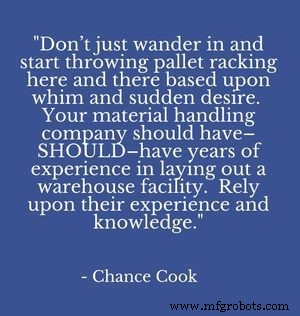
1.计划是成功运营的关键。 “规划你的布局!不要只是徘徊并开始根据心血来潮和突然的愿望到处乱扔托盘货架。您的物料搬运公司应该——应该——拥有多年布置仓库设施的经验。依靠他们的经验和知识。告诉他们您需要做什么,然后仔细听取他们的建议。
“您的基本平面图需要考虑诸如收货和发货地点、暂存区、仓库经理办公室等事项将是,您的员工将在哪里吃午餐,如何访问托盘货架以确定叉车的类型(如果有)。
“所有这些事情都需要提前计划,因为如果没有,那么当你移动东西时随你所想,仓库的货架和整体流动将变得更加拥挤和难以改变。” – Chance Cook,仓库设置:帮助您布置仓库的 11 个技巧 , 乔根森物料搬运
2.预算您的项目。 “首先要考虑的是新货架的预计成本 - 以及设计和安装解决方案的成本。
“这并不总是追求最便宜的。您仍然需要确保您选择的货架能够满足您的要求,但要注意偷工减料。
“我们的建议是考虑‘最佳解决方案成本’,而不是简单地选择最便宜的标准托盘货架。如果您需要更专业的存储解决方案,请准备好在‘托盘流’或‘后推’货架等系统上多花一点钱,并寻求规划和安装专家的帮助。” –选择仓库货架:第一次就做好的十个技巧清单 , Acorn Warehouse Solutions Ltd.
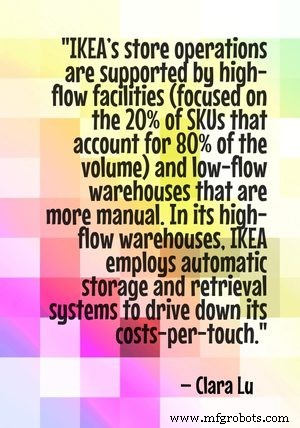
3.宜家等企业通过区分高流量和低流量产品来提高效率。 “宜家的门店运营由高流量设施(专注于占 80% 体积的 20% 的 SKU)和更多人工的低流量仓库提供支持。在其高流量的仓库中,宜家采用自动存储和检索系统来降低每次接触成本。库存在低流量设施中的产品需求量不大,并且操作依赖于手动流程,因为工人不会过多地转移和移动库存。
“这些策略使宜家成为世界上最成功的家具零售商,拥有低运营成本和高产品需求。这使公司能够在不断寻求更先进的方法来简化供应链管理的过程中保持在行业中的竞争力。” – Clara Lu,宜家的库存管理策略:宜家是如何做到的? , 贸易壁虎;推特:@tradegecko
4.在投资附加组件或建立新的配送中心之前,考虑一下可以建立的方法来增加对垂直空间的使用。 “设置垂直存储单元来存放您的库存通常是对仓库面积的最佳利用。在您完全搬迁仓库或计划新的配送中心之前,请考虑建立。它可以帮助避免扩展成本并提高拣货流程的效率。在充分利用现有空间的同时,让较小的物品保持在视线范围内,让较大的物品免受损坏。” –提高仓库生产力的 5 个技巧 ,机架快递;推特:@RackExpress
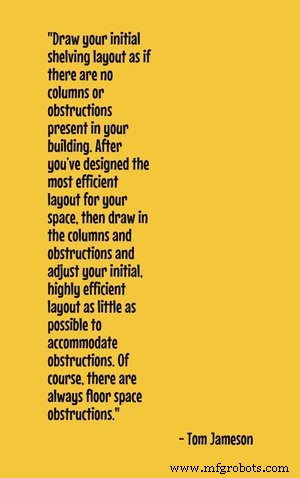
5。要快速有效地设计布局,请忽略现有障碍。 “绘制您的初始搁架布局,就好像您的建筑物中没有柱子或障碍物一样。
“在为您的空间设计最有效的布局之后,然后绘制柱子和障碍物并调整您的初始,高度有效的布局尽可能少地容纳障碍物。当然,总有地面空间的障碍物。
“柱子可能放置在尴尬的地方……加热器、灯、排水管和其他硬件可能会使您的头部空间变得混乱……您的安全工程师可能会提出使您的布局更加复杂的要求
“这就是为什么创建一个高效的货架布局系统总是涉及灵活性和妥协。” – ShelfPlus, Inc. 总裁 Tom Jameson,如何规划和创建高效的工业货架系统 , 节省工业;推特:@Spacesaver
6.将机架排成一排而不是短排,以最大限度地利用空间。 “你可能觉得你拥有世界上所有的空间,但现实是存在一些物理限制。规划空间时需要避免的几件事包括:
- 短时间安排货架。相反,请将它们安排得尽可能长,以充分利用您的存储空间。
- 沿墙壁布置托盘架系统。这会创建一个开放空间,但会限制您的存储效率。
- 创建“L”形存储系统 - 因为这些存储系统太难以导航,而且如果您的叉车需要取放其中的托盘,可能会更加困难。” –为托盘货架系统选择最有效布局的提示 , Material Storage System, Inc.
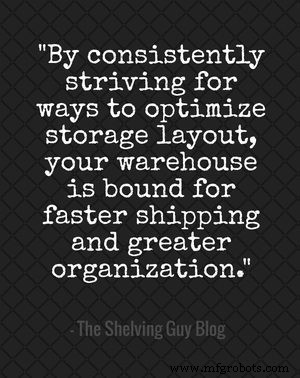
7.始终致力于优化。 “从开销的角度来看,决定将提高效率的存储单元的位置。衡量哪些托盘架、夹层、金属货架和其他类型的存储单元最有利于材料处理和运输流程。通过不断努力优化存储布局,您的仓库必将实现更快的运输和更好的组织。” – 实现最大仓库效率的存储技术 ,搁置者博客;推特:@ShelvingDotCom
8.超大接收区域。 “当我的合伙人 Scott 和我曾经帮助客户设计一个新仓库时,我们要做的第一件事就是为接收功能绘制出令人讨厌的空间。我们非常清楚客户会削减它并扔出更多产品架,但我们想强调空间的重要性。收货是仓库中最关键的功能。这里的一个错误通常会在你得到纠正之前转化为十个额外的错误。让我花点时间翻译一下。分配错误意味着您的净利润减少。
“想想接收团队必须做的所有活动。他们分解托盘。他们清点物品并与制造商的装箱单核对。有时他们会添加条形码标签。有时,制造商会出现运输错误,团队需要暂存产品。物品进来以履行客户的延期订单。我们需要一个地方来容纳这种类型的交叉对接活动。当我们强迫团队在狭窄的地方工作时,就会出现错误。” – Jason Bader,管理合伙人,布置新仓库的技巧 ,分销团队;推特:@Distribution_Tm
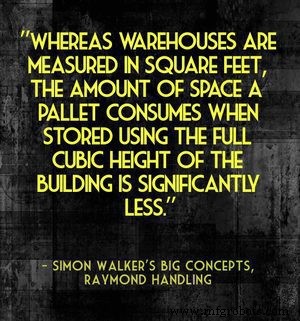
9.计算存储效率。 “存储效率是指存储单个托盘所需的空间量。虽然仓库以平方英尺为单位,但使用建筑物的整个立方高度存储时,托盘消耗的空间量要少得多。
“计算单个托盘存储消耗的平方英尺量的公式是如下:
存储单元的长度 x 宽度(英寸)除以 144 英寸。这给出了存储单元的平方英尺。” –如何计算存储效率 ,西蒙沃克的大概念;雷蒙德搬运;推特:@RaymondHandling
10.没有一种万能的货架和组织方法。 “您的仓库的组织方式对于其运营效率至关重要。你组织它的方式是你的选择——选择最适合你的方法。您可能希望按最频繁销售的顺序存储材料,或者存储倾向于一起销售的项目组。如果您销售季节性商品,这是另一种组织选择。
“通过条形码或 RFID 进行库存确实有帮助,但要更进一步,让您的材料保持有效的顺序。这将在订单填写和库存过程中为您节省大量时间和金钱。” – Jerry Matos,Cherry 物料搬运产品专家,制造仓库:提高效率的 5 个物料搬运技巧 , SAP 的数字化专家;推特:@digitalistmag
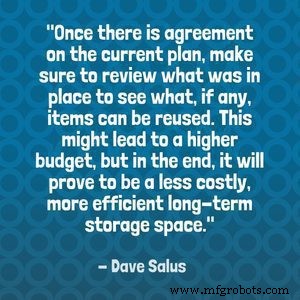
11.不要根据重复使用现有设备来规划空间。 “自从规划了原始空间以来,存储需求可能在 SKU 数量、SKU 大小、数量、可用存储空间以及某些情况下的法规方面发生了变化。因此,必须对规划的空间进行配置,以至少满足当前的需求。这将不可避免地意味着与以前使用的不同大小和类型的存储解决方案。重要的是要根据最后的细节进行相应的计划。一旦就当前计划达成一致,请务必检查已实施的内容,以查看可以重复使用的项目(如果有的话)。这可能会导致更高的预算,但最终,它将被证明是一个成本更低、效率更高的长期存储空间。” – Dave Salus,在设计和组织储藏室和仓库空间时要考虑的 6 个技巧 , 地铁
12.从大型零售商那里获得启示,以提高生产力。 “如果你管理一个更大的仓库,当你第一次走进它时,让整个地方看起来像一个 Lowe's 或 Home Depot 商店并不是一个坏主意。这意味着可以在仓库的通道末端悬挂标牌——事实上,这是一种很好的组织策略,可以帮助您保持组织。
“与一个类别相关的产品将始终存储在通道 X 中,例如,它们永远不会在其他任何地方找到。它使您和在您的仓库中工作的每个人都可以轻松记住物品的位置,并且使培训新员工更容易,更省时,因为如果他们可以的话,他们将不必费力寻找产品的位置抬头看它在过道的标志上。此外,仓库标识解决方案很容易找到,购买成本相对较低,甚至更容易实施。” –组织和管理仓库库存的提示 , 最大物料搬运;推特:@MaxMaterial
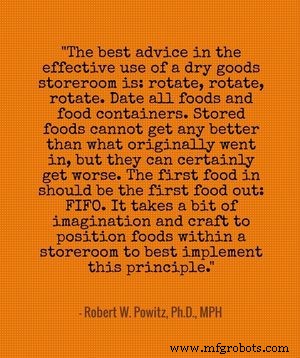
13.考虑特定于应用程序的要求,例如需要轮换易腐烂的物品。 “有效使用干货储藏室的最佳建议是:旋转、旋转、旋转。注明所有食物和食物容器的日期。储存的食物不会比最初放入的食物更好,但它们肯定会变得更糟。第一个进的食物应该是第一个出的食物:先进先出。在储藏室中放置食物以最好地实施这一原则需要一些想象力和技巧。对收到的食品的“使用期限”和“销售期限”以及一般保质期进行方便且易于查看的记录。” – Robert W. Powitz,博士,公共卫生硕士,有效和卫生的干货储存的 7 条简单规则 , 食品安全杂志;推特:@FoodSafetyMag
选择仓库货架
14。标准托盘货架是最常见的仓库货架选项;但是,这些货架需要一条过道才能让叉车进入。 “一旦确定了仓库的总体流程,就必须选择货架以充分利用可用的地面空间。由于几乎所有用卡车运输的材料都存储在托盘上,因此大多数存储设施都使用不同变体的托盘架。
“标准托盘架是任何具有高周转率和许多不同产品的设施的默认选择。叉车司机可以接触到托盘架上的每个托盘。这确保了多年来绝对不会有任何零件被掩埋或丢失。每个存储位置都可以在主列表上进行标记和引用,无论是电子的还是简单地在一张纸上。材料处理人员可以轻松地按照网格示意图跟踪行和列,直到到达要存储材料的位置。
“这种可访问性的好处是有代价的。每组托盘架之间都需要一个通道,以便叉车可以到达托盘。然而,在许多情况下,这种程度的可访问性是不必要的。有时,整辆卡车提供相同的产品。这些滑轨不一定需要单独访问。由于它们都是一样的,它们可以成排存放,后面的被埋起来,直到前面的被移除。” – 仓库布局——如何使用货架优化仓库空间 , 工业仓库货架

15.深通道托盘货架可实现多个托盘存储。 “有两种方法可以在货架中存储多个托盘(深巷托盘存储):将托盘放入货架并让它们利用重力在货架内移动,或者让叉车完全进入(驶入式)或部分进入(深度) 来存储和取回托盘。现在还有第三种方式。
“托盘穿梭车、无线电穿梭车、Pallet Mole 或 Pallet runner 都是自动化深通道托盘存储的例子。该系统有一个小型从属机器人,它进入存放托盘的第二条轨道上的驶入式货架。机器人(穿梭车)将托盘提升到距离存放托盘的货架边缘几英寸处,并将其运送到系统中。” – 托盘货架的优缺点 ,仓库智商;推特:@WarehouseIQ
16.托盘货架系统可以更好地利用垂直空间。 “如果不使用托盘货架系统,一些最成功的企业,如 Costco 和 Sam's Club 会迅速减少。这种组织方法对任何规模的企业都有好处:
- 托盘货架仅在第一年就减少了数百万的仓库支出
- 此外,它还让材料存储变得更加轻松,减少了负担
- 由于托盘货架系统可以垂直储存更多库存,因此您节省的水平空间可能意味着需要开设额外的仓库
- 您的仓库不仅会看起来 托盘货架系统更有条理,但也更安全,因为这些系统是由完全可靠的钢材制成的,在耐用性方面
“实施的难度 : 缓和。对于一家公司来说,改用托盘货架系统可能是一笔巨大的初始投资,但是,其结果无疑是具有成本效益的,并且总体上是值得的。此外,实施托盘货架系统最初也可能需要相当多的额外劳动力;但在大多数情况下,您只需要处理一次这一重大转变。一旦投资得到回报并且托盘货架的指导方针已经建立并根深蒂固,维护变得非常低 。” –7 种方式来组织您的仓库 , 小灵通线

17.随着仓库和配送中心寻求利用每一寸可用空间,多层结构越来越受欢迎。 “包含多层结构的工程系统目前是西太平洋存储解决方案的热门项目,工程副总裁 Mike Guerrero 表示,他的团队正在参与越来越多的此类项目。 “这是我在过去八年中看到的最有趣的趋势之一,”格雷罗说。随着公司将这些多层存储结构整合到他们的仓库中,他说大多数人还希望比以往任何时候都更高——这一目标已经通过有线引导的人工拣选机的发展实现。
“我们”重新制造 20 到 30 英尺高的系统,”Guerrero 说,他指出,人工拣选机通常尾随于货架系统(即,工人从货架上挑选整箱)。然而,随着全渠道配送的迅速兴起,越来越多的公司希望能够从高架/高架货架上挑选分体式箱子或分立元件。
“‘我们已经看到越来越多的此类应用在过去一年左右的时间里,”他补充道。为了满足此类要求,西太平洋制造了 RiveTier Boltless Shelving(适用于两层系统)和可包含三层和四层选项的豪华钢架选项。” – Bridget McCrea,机架、搁板和存储看起来是垂直的 , 现代物料搬运;推特:@modernmhmag
18.您的货架基础设施会因产品尺寸而异。 “货架基础设施将因产品尺寸而异。许多仓库将大型产品存放在散装堆垛或托盘架中。而对于小型产品,可以通过将较小的产品存储在流动货架或静态货架中来提高拣选效率。” –10 大“必备”仓库管理系统 (WMS) 功能 ,iCepts科技集团;推特:@iCepts
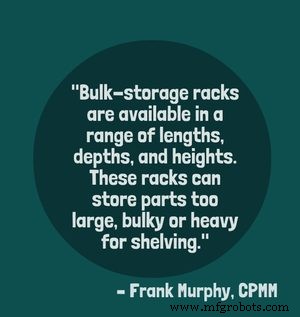
19.考虑为太大而无法搁置的产品使用散装存储架。散装存储架在仓库以外的多个环境中很有用,例如维护和维修部门的储藏室。 “散装货架有多种长度、深度和高度可供选择。这些货架可以存放太大、笨重或太重而无法搁置的零件。空气过滤器、柔性管道系统、较长的空气或液压缸、中型齿轮箱、传送带、减速器、齿轮电机和电机等产品通常存放在大容量存储架上。
“放置在地板上方的横梁使零件存放在地板上。或者主管可以将托盘存放在托盘架下方的地板上,以放置更重、更大的电机、变速箱和机器零件。” – Frank Murphy,CPMM,库存管理:存储注意事项 , 设施网;推特:@BldgOpMgmt
20.在许多仓库中,可移动托盘货架系统是节省空间的宝贵工具。 “可移动托盘货架系统在移动托架上运行,消除了未使用的过道空间,并且几乎可以使您的存储容量翻倍。可移动托盘货架上存储的物品的大小、体积、重量或形状几乎没有限制。这包括几乎任何可以用叉车、卡车或起重机移动的东西。灵活且适应性强的可移动系统几乎可以在任何建筑物支撑或天花板限制范围内工作,并且可以在需要变化时轻松重新配置。它们特别适用于 80% 的滞销或季节性库存。” – Tom Jameson,Pallet Rack 总裁:如何避免在规划和安装过程中出现代价高昂的错误 , ShelfPlus, Inc.
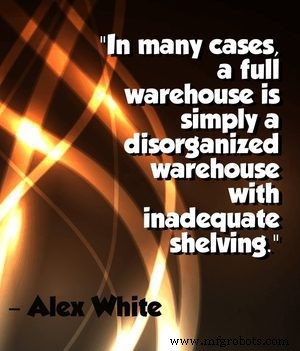
21.一旦您确定了问题区域,定制工业货架解决方案通常可以解决挑战。 “在许多情况下,一个完整的仓库只是一个没有足够货架的杂乱无章的仓库。通过识别问题区域,您将找到提高效率的机会,同时利用每一处空间。占地面积是有限的,但垂直存储可以大大增加可存储的产品数量。垂直存储需要正确类型的产品搁架,重点是安全性和易于取用。对可用仓库空间的利用不足是一个常见问题,而定制工业货架系统很容易解决这个问题。” – Alex White,Western Pacific Storage 高级营销官,如何最大化仓库空间和效率 , 网络效应
22.选择耐用且使用寿命长的仓库货架。 “评估将产品存放在仓库中所需的货架、货架和存储类型。购买坚固的货架/搁板,以尽可能延长使用寿命和磨损。确保它牢固地固定在墙壁和地板上,以防止人员受伤和产品损坏。最后确保单元之间有足够的空间,以便轻松访问所有库存。” – Snapfulfil,Snapfulfil 撰写的 2014 年建立仓库的十个技巧 ,供应链数字化;推特:@SupplyChainD
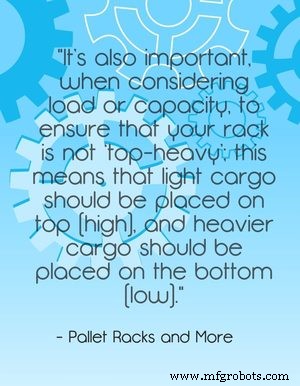
23.考虑负载。 “要记住的关于托盘货架的一个重要提示是考虑负载。你打算储存什么?这将影响你是否会选择:
- 轻型货架(例如,负载能力不超过 660 磅)
- 中型托盘货架(例如,负载能力在 660 到 1,320 磅之间)
- 重型托盘货架(例如,负载能力超过 1,320 磅)
“机架的容量必须与其承受的负载相对应。每个货架上的货物重量不得超过托盘的最大容量;你不应该让货架超载,即使货架目前似乎能够承受重载。在考虑负载或容量时,确保您的机架不是“头重脚轻”也很重要;这意味着轻的货物应该放在顶部(高),重的货物应该放在底部(低)。” – 托盘货架提示 、托盘架等
24.正确的仓库货架系统对于确保安全至关重要。 “不均匀的堆栈可能不稳定且不安全。当仓库物品堆放不当时,您可能会冒单个物品甚至整堆物品掉落并可能伤害他人的风险。确保所有堆叠均匀,最重的物品放在底部。投资符合当前安全标准的高质量货架设备对您员工的安全至关重要。” – 5 个基本仓库安全提示 , 物料搬运交流
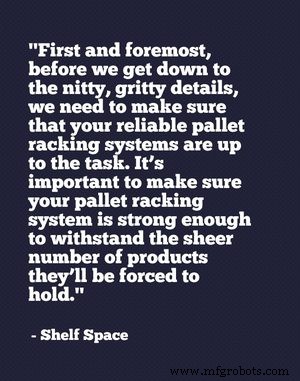
25.确保实施强大而稳定的仓库货架系统。 “首先,在我们深入了解细节之前,我们需要确保您可靠的托盘货架系统能够胜任这项任务。重要的是要确保您的托盘货架系统足够强大,能够承受他们将被迫持有的大量产品。十二月和一月是新旧一年中最繁忙的两个月份。 12 月带来了圣诞节购物者的热潮,拼命想记住为他们的朋友和家人购买产品,而 1 月带来了销售的迷恋。
“你最不想要的就是发现你的货架找不到应付绝对的重量。为了应对货架陈旧的威胁,请确保将较重的产品放在最底层的货架上。” –仓库运输安全提示 , 货架空间
26.模块化边缘货架系统提高了可达性和工人的安全性。 “模块化边缘是托盘货架系统的一种变体,是仓库存储服务的首选。该系统提高了工人的可及性并确保了安全。系统的存储容量可以通过使用框架保护装置、防倒塌系统、钢网架、甲板面板和额外支撑等配件来增强。
“组织可以从各种托盘货架解决方案中进行选择。但是,在选择合适的因素时,建议考虑以下因素:
- 要储存的材料的数量或装载量。
- 仓库中的可用空间,以确定货架系统的大小。
- 仓库的高度限制。
- 获取材料的媒介和处理过程。
- 要存储的材料类型。” –仓库托盘货架系统使用指南 ,亚特兰大户外淋浴
平衡空间和可访问性
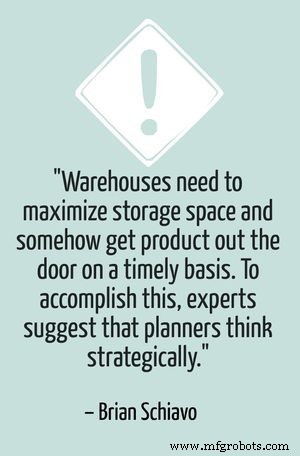
27.正确的布局和机架选项很大程度上取决于产品组合。 “仓库需要最大限度地利用存储空间,并以某种方式及时将产品送出门外。为了做到这一点,专家建议规划者进行战略性思考。
“‘这真的取决于产品的组合,’汤普金斯的 Hudock 说。当他的公司与客户协商时,他需要了解各种信息,例如各种产品的保存时间,以及所涉及的批次大小。
“货架解决方案通常取决于客户的业务类型。设施迎合。对于向餐厅提供特色食品的餐饮服务公司,专家建议采用浅货架。 “这类产品不会在货架上放很长时间,”库里说。 “这些类型的操作应考虑单深、选择性货架或两深后推。”
“快速周转大量货物(如冷冻炸薯条)的散装存储设施应使用一些深度存储,并根据对同一主题的不同 SKU 进行两次深度货架,如皱切法式炸薯条、牛排薯条等。” – Brian Schiavo,最大化空间与。可访问性 , 食品物流;推特:@FoodLogistics
28.设计有效系统的第一步是考虑存储密度和产品选择性的反作用力。 “设计有效和卓越的托盘存储系统的第一步是优化组合存储密度和产品选择性的关键(但通常是相反的)功能。平衡存储系统需要考虑的因素包括:托盘化的 SKU 总数、阈值库存数量超过 1 个托盘负载和多达或超过 20 个托盘负载的数量、库存周转( F.I.F.O.) 要求,以及产品选择和补货的方法。高密度存储提高了空间利用率,但最大限度地减少了单个 SKU 托盘装载访问。与高密度存储阵列相比,对所有单个托盘的直接‘面对面’访问(选择性)通常需要更多的过道空间。” – Patrick Thibault,设计优化:托盘存储架中的创意解决方案 , 温赖特
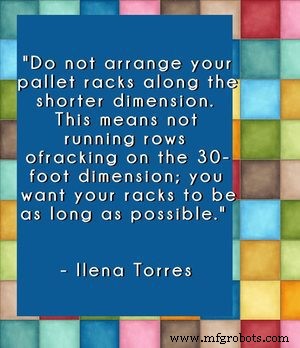
29.始终将机架安排得尽可能长。 “以 56 英尺乘 72 英尺的房间为例,您需要在设计中避免一些事情。
- 请勿沿较短的尺寸排列托盘架。这意味着不在 30 英尺尺寸上运行一排排货架;您希望您的机架尽可能长。
- 不要在所有四个墙壁上都布置机架,从而在内部形成一个带有更多机架的外围系统。这根本就没有效率。
- 请勿将您的机架打造为“L”形,这会导致您的地面空间损失约 5%。
- 请勿沿墙设置通道。最后一排应该靠墙。” – Ilena Torres,如何决定高效的托盘货架布局 , 喜立方;推特:@HiCube
30。移动您的架子和搁板,以便更方便地使用。 “移动托盘架和货架是如何工作的?通过将现有或新的托盘架或搁板放置在连接到地板轨道的托架上,您可以将它们压在一起并创建可移动的过道。它对你有什么作用?它不仅可以冻结您的仓库占地面积,还可以收回超过 50% 的仓库存储空间,这意味着您可以将现有存储容量翻倍,或者将这些空间完全用于其他用途。观看此视频,了解有关移动式托盘架和搁板的更多信息。” – 有效节省空间的技巧:冻结您的仓库足迹 , 西南解决方案集团
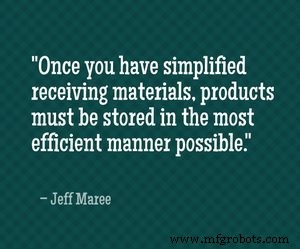
31. If your employees are spending hours searching for the right product, you’re losing the cost battle – no matter how efficient your rack system is in theory. “Once you have simplified receiving materials, products must be stored in the most efficient manner possible. If employees are spending hours locating and retrieving items, you are losing the cost battle. By using the right inventory system, your workers can know exactly where to look for each item when placing them into storage or picking them for shipment. Programs can also be designed to group items by location, preventing hours of back-and-forth trips by employees or lift trucks.
“You also need to make the best use of warehouse storage. Shelving racks are no longer a one-size-fits all application. If you have an overload of products in one location with contents spilling on to the floor, and empty racks on the other end of your warehouse, your method is not working.
“A customized storage solution will keep your materials organized. By using the right options, you can also eliminate the need for expanding your warehouse space. Fluctuating inventories should not create an overload. If you need to search for more space on a regular basis, you should invest in a better system.” – Jeff Maree, Applying Lean Principles to Warehouse Management , Manufacturing Transformation; Twitter:@Apriso
32. Ensure easy product availability by arranging racks and shelving units in a system of aisles and cross-aisles. “Ensure quick product availability by having a system of aisles and cross aisles that make it easier to move around your warehouse. Long and continuous aisles can make it difficult in getting from one part of the warehouse to another. However, cross aisles that allow access to the main aisles, help create a grid that is more efficient and easier to navigate.
“The goal of the warehouse layout is to optimize your warehousing functions and achieve maximum efficiency and space utilizations.” – Improving the Layout of Your Warehouse , Adaptalift; Twitter:@aalhyster
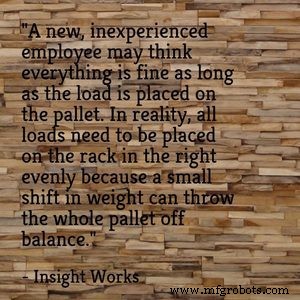
33. Distribute weight evenly, and train employees to do the same. “A new, inexperienced employee may think everything is fine as long as the load is placed on the pallet. In reality, all loads need to be placed on the rack in the right evenly because a small shift in weight can throw the whole pallet off balance.
“This is where safety training comes into play. It is wise to have drivers be certified in forklift operations to ensure safety. Companies may also want to require training in maintenance and operational training when it comes to pallet racking and forklifts.” – Tips for Warehouse Pallet Racking , Insight Works; Twitter:@DMSInsightWorks
34. Be sure to secure your shelves. “Commercial shelving is often meant to store bulkier items and therefore, must be durable enough to hold heavier weights, but also built in a way where they will not tip or sway. Choose the material of your shelving based on what you want to store or use wall mounting brackets to secure the shelves in place.” – Top 5 Warehouse Shelving Safety Tips , Action Wholesale Products; Twitter:@Action_WP
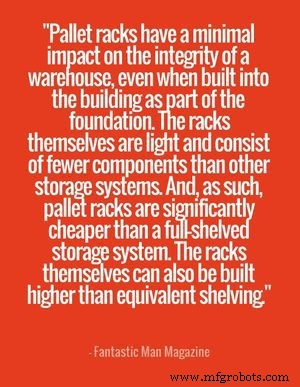
35. Racks have a few advantages over shelves, including airflow. “Pallet racks have a minimal impact on the integrity of a warehouse, even when built into the building as part of the foundation. The racks themselves are light and consist of fewer components than other storage systems. And, as such, pallet racks are significantly cheaper than a full-shelved storage system. The racks themselves can also be built higher than equivalent shelving.
“On top of this, pallet racks offer great visibility of your stock, as well as excellent ventilation and airflow.” – The Benefits of Pallet Racking , Fantastic Man Magazine
Racking and Picking Approaches to Improve Workflows
36. Consider the expected time to pick (ETP). “Sometimes it is difficult to see the warehouse for what it really is—a collection of pallet positions where inventory is put away and picked at varying frequencies. The key to distribution efficiency is making better use of warehouse real estate, according to Terry Harris, managing partner, Chicago Consulting.
“Companies often put away inventory without considering how that position impacts future processes. Without directed putaway, decisions are left up to the operator, or the use of a traditional zone structure.
“Warehouse real estate demands a more common-sense approach to visualizing inventory turns within the facility—a term that Harris refers to as expected time to pick (ETP).
“In most warehouse operations, picking is more time-consuming than putaway. That’s where labor generally resides. Warehouses need to optimize slotting to ensure pallet positions and storage profiles match the flow of goods within a specific facility.
“Harris’ premise is that traditional zone picking and putaway conventions do little to increase speed or efficiency within a facility. They force companies into using a protocol for prioritizing inventory that doesn’t go far enough.
“‘Zones create groups of positions,’ Harris says. ‘The theory is that every position in that zone has the same real estate value, but that’s rarely the case. By contrast, you can differentiate down to the pallet position within that zone. It’s the logical extension.'” – Joseph O’Reilly, Innovative Warehouse Strategies:Four Walls, Three Takes , Inbound Logistics; Twitter:@ILMagazine
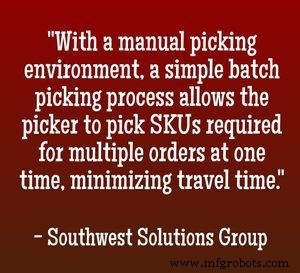
37. Batch picking enables workers to pick more than one order at a time, but for large batches with multiple orders, it’s best to have software to ensure accuracy. “This strategy involves picking more than one order at a time and can be achieved with both manual and automated picking. With a manual picking environment, a simple batch picking process allows the picker to pick SKUs required for multiple orders at one time, minimizing travel time. This type of manual batch picking works best with smaller SKUs, as manual picking with larger SKUs leaves a greater risk for error. When batch picking more than a few orders at a time, it’s best to integrate software to maintain accuracy rates. The software can optimize picks, direct the worker to the picking location, and verify the quantity to pick.” – Types of Picking Strategies to Maximize Productivity in Warehouse Operations , Southwest Solutions Group
38. FIFO rack systems are an intuitive solution for optimizing warehouse workflows. “First-in, first-out, or FIFO, is a type of inventory management that allows inventory placed into a rack system first to be removed first. FIFO rack systems are ideal for customers requiring rapid stock rotation, have a high turnover rate for inventory, or store items with expiration dates. For example, FIFO food storage applications allows for constant product movement, safeguarding that no inventory spoils or goes to waste.” – FIFO Rack Systems , REB Storage Systems International; Twitter:@REB_Storage
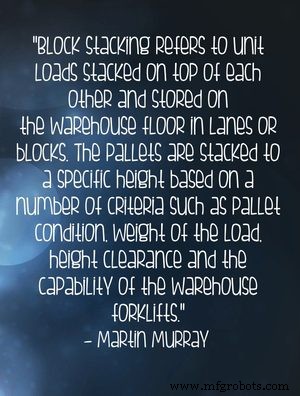
39. Block stacking is a cheap-to-implement method and a good choice for some warehouses. “Block stacking refers to unit loads stacked on top of each other and stored on the warehouse floor in lanes or blocks. The pallets are stacked to a specific height based on a number of criteria such as pallet condition, weight of the load, height clearance and the capability of the warehouse forklifts.
“The pallets are retrieved from the block in a last in, first out (LIFO) manner. This does not allow for removing stock based on date basis or FIFO. Removal of stock can cause honeycombing to occur where empty spaces occur that cannot be filled until the whole lane is empty.
“This method is cheap to implement as it involves no racking and can be operated in any warehouse with open floor space.” – Martin Murray, Pallet Storage Methods in the Warehouse , About Money; Twitter:@AboutMoney
40. Don’t hesitate to re-slot product often. “Re-slot your pick positions as often as necessary. Up to 60% of a picker’s daily activity can be involved in travel time (afoot or on a forklift or walkie), so reducing that time-spend is an excellent idea. A good product slotting strategy can reduce travel time thereby reducing picking labor. Always weigh the time and cost of a complete re-slot against the costs of it. Busy operations re-slot their fast moving, high-profit SKU’s every day. Slotting the facility once and leaving it that way for years is typically a recipe for wasted time and money.” – Scott Stone, Best Practices for Warehousing – 13 Tips for Productivity , Cisco-Eagle; Twitter:@CiscoEagle

41. Pareto your inventory for analysis. “Gather sales and inventory in dollars by item. Construct two Pareto charts. For the first chart, classify your items into A, B, C, and D (80%, 15%, 5%, 0%) based on sales. Then calculate your inventory for each group. Do your A items represent 50% of your inventory? If not, you may not have enough inventory for these items. A significant amount of inventory on low demand items may indicate problems with product run-outs, transitions, engineering change management, and managing obsolete inventory.
“For the second chart, classify your items based on inventory. Then calculate the sales for each group. Again, do your A inventory items represent at least 50% of your sales? If not, inventory may be out of balance. These charts are an excellent way to begin looking at your inventory. After gathering this information, you have the makings of a supply chain data warehouse for further analysis.” – Chuck LaMacchia, The Progress Group, LLC, Ten Ways to Reduce Inventory, While Maintaining or Improving Service , ShelfPlus
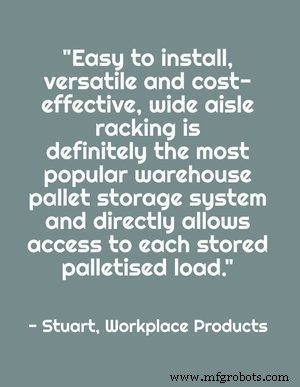
42. Wide aisle racking is a popular approach allowing easy access to each stored, palletised load. “Easy to install, versatile and cost-effective, wide aisle racking is definitely the most popular warehouse pallet storage system and directly allows access to each stored palletised load. Adjusting beams, accommodate re-configurable warehouse layouts. Therefore the versatility comes from allowing the type of goods that are stored to change with the business model. Wide aisles give the space needed to allow all forklift traffic easy access throughout the Racking layout. This Wide Aisle style renders specialised handling equipment unnecessary.” – Stuart, Efficient Warehouse Storage Solutions – ‘Our 10 Step Pallet Racking Guide’ , Workplace Products; Twitter:@WorkplaceProd
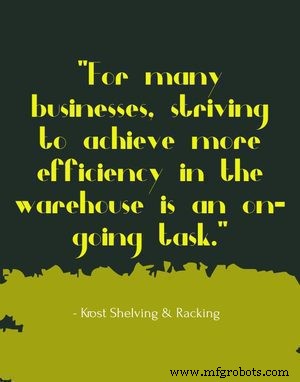
43. Remember that racking is one component of a multi-faceted process. “For many businesses, striving to achieve more efficiency in the warehouse is an on-going task. Many businesses implement Warehouse Management Systems, others improve workflow by upskilling staff and employing floor supervisors to ensure that work gets done and processes are followed.
“Another way to achieve a more streamlined work process is to make use of the correct equipment. This encompasses a range of items, from the type of shelving and racking you have, to the lifting equipment like forklifts to move materials.” – Improve Warehouse Efficiency Today with These Easy Tips , Krost Shelving &Racking; Twitter:@Krost_Shelving
44. The random organization method makes better use of all available space. “The Random method places inventory where ever it fits. The fixed method, on the other hand, has designated locations for each product. This second system can be more organized, but can also produce a lot of wasted space.” – Modern Rules of Warehouse Efficiency , Pallet Rack Now; Twitter:@PalletRackNow
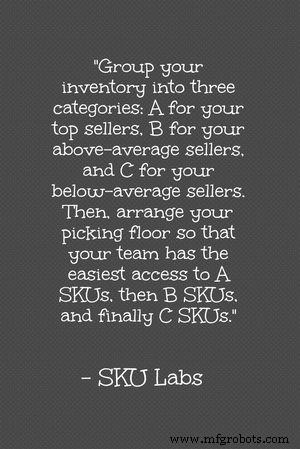
45. ABC grouping helps to optimize product placement. “E-commerce retailers can very likely identify a small portion of their inventory that is more frequently picked and shipped than the rest. These golden tickets to profit are being shipped more often, and need to be in stock more consistently, than the vast majority of the remaining catalog. To make picking and counting these items easier (especially when using cycle counting), group your inventory into three categories:A for your top sellers, B for your above-average sellers, and C for your below-average sellers. Then, arrange your picking floor so that your team has the easiest access to A SKUs, then B SKUs, and finally C SKUs.” – 5 Warehouse Organization Tips for Ecommerce Retailers , SKULabs; Twitter:@skulabs
46. Ensure that fast-moving products are within an arm’s reach. “The second strategy to deploy for efficient warehouse operations is to use the right storage options. Seldom would you think that the storage containers holding your merchandise could, in fact, be slowing down your operations. Yet, when employees have to dig through storage containers and bins as products tip off shelves, there has to be a better way to store your items. Fast-moving items that move in bulk can be kept in cartons and pallet racks on the floor level for easy handling when placed into the store or out to delivery trucks. Items that are slow movers can be put in the appropriate bins on shelves.
“Always select the storage options that are the best fit for the types of products that you sell. Also, keep in mind that warehouse staff can have a faster time fulfilling orders for in-demand products when the items are in arm’s reach. Storing merchandise at waist level allows the staff to “grab and go” when filling multiple orders. However, keep in mind that the weight of the item will also dictate where it is placed, as heavier products will need to be put on lower shelves or on pallets.” – Denny Hammack, President, Patterson Pope, Top 5 Ways for a More Efficient Warehouse Operation , Supply Chain Brain; Twitter:@SCBrain

47. Focus on reducing handling and touches. “The fewer times that your workforce has to touch the product, the lower your overall costs of fulfilling orders is. Work on streamlining your processing in order to lower your costs.” – Tips and Tricks for Saving Money In Your Warehouse , Used-PalletRack.com
48. When you think you’re at your working capacity, you’re probably not. “Working capacity is how much storage a space can hold based on the configuration of the physical space and inventory characteristics, such as the size and shape of items. Most businesses think their storage facility is running at full capacity when in reality, it’s probably around 60 to 80 percent. Failure to run a warehouse at full working capacity costs a business money, especially if a second facility is purchased or rented to handle overload from a warehouse that isn’t even at working capacity.” – Effective Warehouse Space Matters to the Bottom Line , Brendamour Warehousing
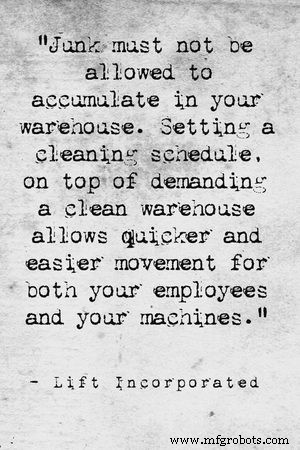
49. Even the best racking systems can become inefficient if not maintained. “Keep it organized and clean. Junk must not be allowed to accumulate in your warehouse. Setting a cleaning schedule, on top of demanding a clean warehouse allows quicker and easier movement for both your employees and your machines. You may even find some missing or misplaced orders.” – 5 Tips for a More Efficient Warehouse , Lift Incorporated; Twitter:@Liftincorpor
50. Keep your warehouse in logical order after initial setup with ongoing optimization and prioritization efforts. “An orderly warehouse is a profitable warehouse. Picking operations, whether run from your garage business or a multi-location operation, are the lifeblood of your business. With less traditional businesses taking up brick and mortar retail spaces, and more organizations opting to sell only online, a logically laid-out warehouse can lessen cost and bolster the bottom line. Re-assess your process and warehouse configurations for efficient order picking and shipping.
“The following are our tips for a sensible warehouse:
- Prioritize your products – It isn’t likely that your most popular products will remain so from season to season. By bringing trending items to the more accessible shelving helps you ensure against lost man hours (and we all know that lost time is lost money). Implement a slotting process that is dynamic, changing where and when needed.
- Analyze the processes – If needed, hire a consultant that can help your organization with optimizing your order picking methods. Whether you use batch or zone picking, a single picker, multi-orders or single, re-evaluating the process is likely to show you some money-draining holes that can be covered. Take the recommendations from staff seriously as they are in the job on a daily basis and know the frustrations better than anybody.
- Use big data and software to fully optimize shelving space – Knowing which products are most likely to be ordered together or what colors, styles or textures are trending can help you determine product spacing, saving travel time for pickers.
- Reduce shipping options – Having multiple sizes of shipping containers and boxes seems to make sense on the surface but too many choices slows down the process. Offer pickers an easier way to pack orders with just a few options. It will limit time spent searching, reduce freight and container expenses for the entire warehouse.” – Sensible Tips for an Orderly Warehouse , Felix Loeb
Asset Tracking Solutions from Camcode:
- Custom Asset Tags
- 50 Asset Tracking Tips
- 53 Asset Tracking Software Tools
- Custom Warehouse Hanging Signs
- Warehouse Label Solutions
- Durable Floor Labels
- Rack Labels for Every Occassion
工业技术


